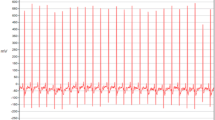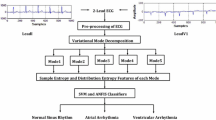Abstract
The paper presents a field-programmable gate array (FPGA)-based fast processing system with 12-channel high-resolution (24 bits) front-end for ECG signal processing. The implemented high-resolution data conversion makes the system suitable for recording of late potentials of the QRS complex in patients prone to sustained ventricular tachycardia. The system accepts ECG signals through 12 channels and then filtered to minimize baseline wander and power-line interference. The filter outputs are connected to 12 delta-sigma ADCs. The whole ADCs work synchronously at 8 kHz sampling frequency, and their output data are transferred to an FPGA that computes online on the digitized sample values in real time and ascertains whether the patient under study suffers from ventricular tachycardia or not. In order to ascertain the QRS complex accurately in the noisy ECG signal, fuzzy entropy of the sample values has been computed and provided as an input to inverse multiquadratic radial basis function neural network. Using the standard CSE ECG database, the algorithm performed highly effectively. The performance of the algorithm in respect of QRS detection with sensitivity of 99.83 % and accuracy of 99.7 % is achieved when tested using single-channel ECG with entropy criteria. The performance of the QRS detection system has been compared and found to be better than most of the QRS detection systems available in the literature. Using the system, 200 patients have been diagnosed with an accuracy of 99 %.






Similar content being viewed by others
References
Benitez D, Gaydecki PA, Zaidi A, Fitzpatrick AP (2001) The use of Hilbert transform in ECG signal analysis. Comput Biol Med 31:399–406
Brown ML, Christensen JL, Gillberg JM (2002) Improved discrimination of VT from SVT in dual-chamber ICDs by Combined analysis of dual-chamber intervals and ventricular electrogram morphology. Comput Cardiol 29:117–120
Chen SW, Chen HC, Chan HL (2006) A real time QRS detection method based on moving-averaging incorporating with wavelet denoising. Comput Methods Prog Biomed 82:187–195
Christov I, Gómez-Herrero G, Krasteva V, Jekova I, Gotchev A, Egiazarian K (2006) Comparative study of morphological and time-frequency ECG descriptors for heartbeat classification. Med Eng Phys 28(9):876–887
Engelse WAH, Zeelenberg C (1979) A single scan algorithm for QRS detection and feature extraction. Comput Cardiol IEEE Comput Soc 6:37–42
Fraden J, Neurman MR (1980) QRS wave detection. Med Biol Eng Comput 18:125–132
Gramatikov B (1993) Detection of late potentials in the signal averaged ECG combining time and frequency domain analysis. Med Biol Eng Comput 31:333–339
Gramatikov B (1993) Digital filters for the detection of late potentials in high-resolution ECG. Med Biol Eng Comput 31:415–420
Gritzali F (1988) Towards a generalized scheme for QRS Detection in ECG Waveforms. Sig Process 15:183–192
Kim B, Lee DW, Parka KY, Choi SR, Choi S (2004) Prediction of plasma etching using a randomized generalized regression neural network. Vacuum 76:37–43
Knopfmacher J (1975) On measures of fuzziness. J Math Anal Appl 49:529–534
Kohler BU, Henning C, Orglmeister R (2002) The principles of software QRS detection. IEEE Eng Med Biol 21(1):42–57
Kyrkos A, Giakoumakis EA, Carayannis G (1988) QRS detection through time recursive prediction technique. Sig Process 15:429–436
Mehta SS, Lingayat NS (2007) ECG pattern classification using support vector machine 12-lead combined entropy. In: The sixth international conference on advances in pattern recognition 2007. Indian Statistical Institute, Kolkata, India
Mehta SS, Lingayat NS (2008) Development of SVM based classification techniques for the delineation of wave components in 12-lead electrocardiogram. Biomed Signal Process Control 3(4):341–349
Mehta SS, Lingayat NS (2008) Combined entropy based method for detection of QRS complexes in 12-lead electrocardiogram using SVM. Comput Biol Med 38:138–145
Molina GA, Cuesta G, Frau D, Miró G, Martinez P, Oltra G, Crespo S, Aboy M (2013) Influence of QRS complex detection errors on entropy algorithms. Application to heart rate variability discrimination. Comput Methods Prog Biomed 110:2–11
Murthy ISN, Prasad GSSD (1992) Analysis ECG from pole zero models. IEEE Trans Biomed Eng 39(7):741–751
Okada M (1979) A digital filter for the QRS complex detection. IEEE Trans Biomed Eng 26(12):700–703
Pan J, Tompkins WJ (1985) A real time QRS detection algorithm. IEEE Trans Biomed Eng 32:230–236
Shingae PP, Shinde RV (2014) Analog to Digital Converter using Delta Sigma loop for the application portable ECG Device. In: IEEE international conference on recent advances and innovation in engineering, May 09–11. Jaipur, India
Wellens HJ (2001) Ventricular tachycardia diagnosis of broad QRS complex tachycardia. Heart 86:579–585
Yanai H, Sawada Y (1990) Associative memory network composed of neurons with hysteresis property. Neural Netw 3:223–228
Author information
Authors and Affiliations
Corresponding author
Ethics declarations
Conflict of interest
There is no conflict of interest.
Ethical standards
The patient data and analysis of the same have been carried out with approval of Ethics Committee of IIT Hyderabad and the Institute Review Board (IRB) of KIMS Hospital, Hyderabad.
Informed consent
All patient data have been taken with informed consent in conformance with the Declaration of Helsinki.
Rights and permissions
About this article
Cite this article
Roy Chowdhury, S. High-resolution detection of sustained ventricular and supraventricular tachycardia through FPGA-based fuzzy processing of ECG signal. Med Biol Eng Comput 53, 1037–1047 (2015). https://doi.org/10.1007/s11517-015-1364-x
Received:
Accepted:
Published:
Issue Date:
DOI: https://doi.org/10.1007/s11517-015-1364-x




